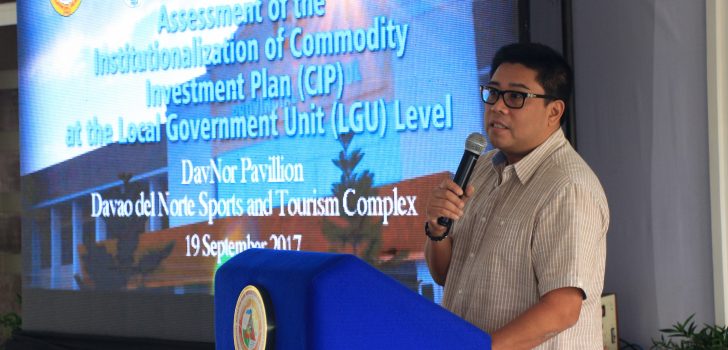 Davao del Norte Governor Anton Del Rosario shares the LGU’s experience in the implementation of their PCIP, which was cited as one of the best in the country during assessment activity conducted by the DA-Philippine Rural Development Project (PRDP). Photo by Jay Rosas
Davao del Norte Governor Anton Del Rosario shares the LGU’s experience in the implementation of their PCIP, which was cited as one of the best in the country during assessment activity conducted by the DA-Philippine Rural Development Project (PRDP). Photo by Jay Rosas Davao del Norte lauded for its PCIP implementation
Tagum City – The province of Davao del Norte has been strongly commended for having one of the best provincial commodity investment plan (PCIP) in the country during the assessment activity spearheaded by DA’s Philippine Rural Development Project (PRDP).
The activity was aimed at evaluating the institutionalization of the PCIP as a planning tool in PRDP-implementing provinces.
“Our PCIP now serves as ready reference of the province to access funding from different national agencies and helps facilitate in the identification of possible entrepreneurial opportunities,” said Davao del Norte PPMIU Head Engr. Josie Jean Rabanoz.
The activity composed of three focus group discussions (FGD) involving the project planning, monitoring and implementing unit (PPMIU) of the province, national government agencies, and project stakeholders like farmers’ organizations, cooperatives and other private sector.
Rabanoz cited the support of the local leadership and strong multi-sectoral involvement in the formulation of their PCIP as facilitating factors of its good implementation.
“Right from the start, the local chief executives of Davao del Norte have been well informed about the PCIP and other national government agencies are well represented,” she said.
The PPMIU respondents also noted the availability of local plans like the barangay development plans (BDP) and the conduct of workshops and consultations as helpful in the PCIP formulation.
Provincial stakeholders cited that the PCIP serves as investment guide for effective resource allocation, facilitates convergence, considers value adding, and is market oriented.
Among the benefits of the PCIP cited by the FGD respondents include: availability of robust data for planning process, provides direction in terms prioritization of projects, and use of scientific tools that allow objective selection of interventions.
Davao del Norte’s PCIP is also instrumental in the organization of the province’s Cacao Industry Council, “as an offshoot of the PCIP.”
Provincial stakeholders also state that PCIP can be used to make products more competitive and in strengthening commodity-based councils and associations.
“The PCIP ensures that there will be continuity of implementing projects despite changes in polictical leadership,” said PRDP Project Director Ricardo Oñate Jr.
He adds: “Davao del Norte has shown its readiness and has equipped itself with the right capabilities to implement PRDP projects in the province.”
In its mid-project implementation, PRDP is working towards mainstreaming the PCIP as a planning tool to provide directions in local investment planning and capacitating LGUs in identifying appropriate development interventions. (Jay M. Rosas/PRDP Mindanao)
